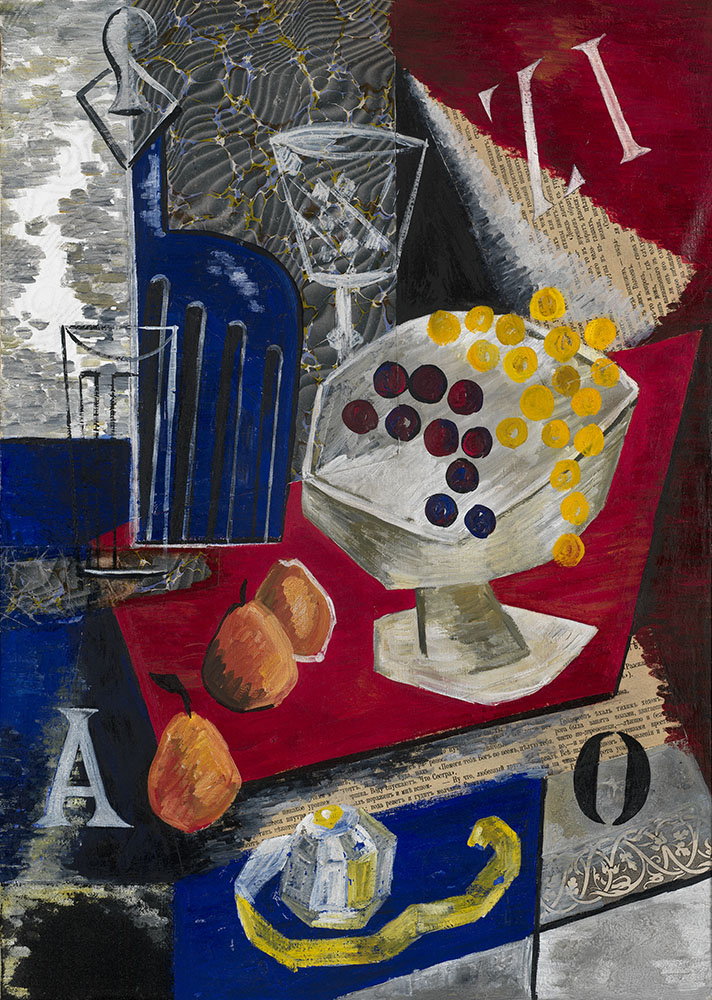MacDougall Auctions 12-18 June 2008
12 June 2008

* 41. EXTER, ALEXANDRA 1882-1949
Still Life c. 1912-1913.
Oil, tempera, textile, collage on canvas, 50 by 35.5 cm.
180,000-250,000
Provenance: Private collection.
Authenticity certificate from Professor G. F. Kovalenko, the State Insitute of Fine Arts.
Chemical analysis report from professor Hermann Kühn, Munich, dated 4 July 2003.
The work will be included in the catalogue raisonne, prepared by professor G. Kovalenko.
Literature: Bubnovyi Valet in Russian Avant-garde, The State Russian Museum; State Tretyakov Gallery; Cultural Fund "Ekaterina"; Palace Editions, St. Petersburg, 2004, p. 23 illustrated.
Liwschiz, Benedikt. Der Anderthalbaugige Schütze, Palace Editions, St. Petersburg, p. 42 illustrated.
1912–1914 were special years in the life of Alexandra Exter. It was a time when Cubo-Futurism was finding expression in her paintings as she maintained an ongoing artistic dialogue with Ardengo Soffici, the Italian painter who was a close friend of the artist. The effects of this are obvious, especially if one compares the still lifes of the two artists: they painted the same figural compositions with the same combination of objects: long-stemmed wineglasses, bottles, tumblers, apples and pears, pieces of watermelon, eggs. Both Exter and Soffici introduced numbers, letters, inscriptions and collages into their still lifes.
A study of Exter’s compositions from this period, including the one presented here, is most interesting: there are two tangible interactive factors – the Cubist approach to form and Futurist energy, which strives to transform the fabric of the still life. The result is a medium which is dynamic, bubbling and lively.
Exter’s Cubo-Futurist still lives are emphatically material. Everything is endowed with meaning and significance: the colour and density of the bottle glass, the crystal of the wineglasses, the matt faience of the bowls… At the same time, in juxtaposing objects that are completely different in texture, Exter seeks a way to bring them together, to unite them, to present each one as a manifestation of a single, inseparable fabric.
Cubist techniques enable her to do this: a system of horizontal strokes, whitening and interpenetrating, skewed contours. This gives a fairly integral fabric – fluid and pulsating, without being monotonous and uniform. Something is always going on, a shape seemingly trying to break free, desperately trying to assert its unique substantiality, then letting go, sinking into the depths of the fabric. This play is eternal in Exter’s still lifes. It is proof of the unstoppable movement of the fabric, its inherent dynamism. One more thing: this still life is eloquent proof of Exter’s attempt to achieve a Futurist position in a Cubist painting. Here can be clearly seen the way the artist subjugates the constructive quality of Cubism to the dynamic world view of Futurism.
Professor G. Kovalenko.
Notes on symbols:
* Indicates 5% Import Duty Charge applies.
Ω Indicates 20% Import Duty Charge applies.
§ Indicates Artist's Resale Right applies.
† Indicates Standard VAT scheme applies, and the rate of 20% VAT will be charged on both hammer price and premium.